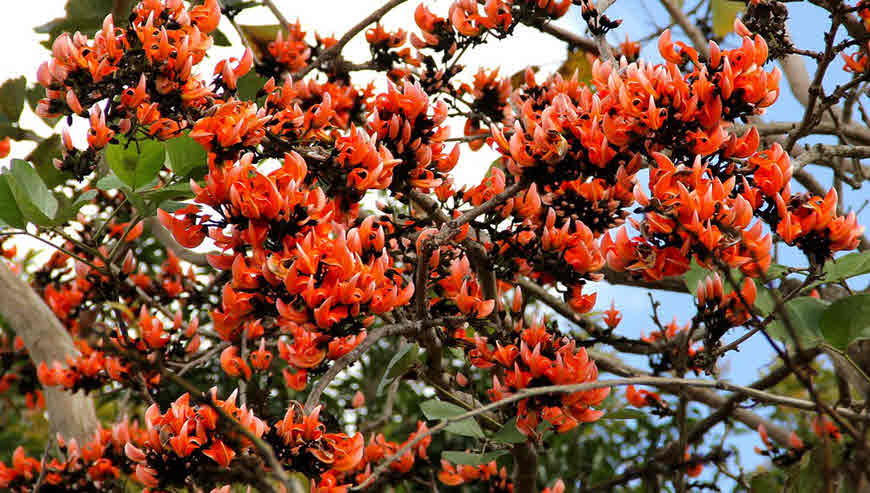Butea is also known as Dhak, Palas, Palash, Flame of The Forest, Bastard Teak, Parrot Tree, Bengal kino. It is medium-sized tree found in tropical and subtropical regions of Indian sub-continent such as India, Bangladesh, Nepal, Sri Lanka, Myanmar, Thailand, Indonesia, Vietnam, and Malaysia.

The blooming season of the tree is from April and it looks magnificent due to its orange flowers. After flowering, fruiting happens to appear from the month of May to July. A Gum is also obtained from the tree known as gum kino or Bengal kino gum. The gum is prepared from red juice secreted by the bark.
Butea gum has anthelmintic, anti-conceptive, anticonvulsive, antidiabetic, antidiarrheal, antiestrogenic and antifertility, antimicrobial, antifungal, antibacterial, antistress, chemopreventive, haemaggultinating, hepatoprotective, radical scavenging, thyroid inhibitory, antiperoxidative and hypoglycemic effects and wound healing activities.
Butea belongs to the subfamily Caesalpinioideae, of family Fabaceae or Leguminosae. This moderate sized deciduous tree is widely distributed throughout India. It is traditionally reported to possess astringent, bitter, alterative, aphrodisiac, anthelmintic, antibacterial and anti-asthmatic properties.
Palas Tree Synonyms (Also known as)
- Name: Butea monosperma (Lamk.) Taub.
- Synonym: Butea frondosa Koenig ex Rox
- Hindi: Dhak, Palas, Tesu, Palash
- English: Flame of the forest, bastard teak, Bengal kino
- Bengali: Palas
- Gujarati: Khakharo
- Marathi: Kakracha
- Telugu: Mooduga, Palasamu
- Tamil: Parasa
- Kannada: Muttuga
- Malayalam: Brahmabriksham, Kimshukam
- Punjabi: Dhak, Palash
- Thai: Tong kwao
- Ayurvedic: Palasha, Kimshuka, (Charaka, Sushruta)
- Palashaka, Raktapushpak, Ksharashreshtha,
- Brahma-vraksha, Samidvar
- Unani: Darkht-e-Palah (Persian), Dhaka, Tesu
- Siddha: Parasa
Parts Used for Medicinal Purposes
- Flowers
- Leaves
- Bark
- Stem
- Gum
Chemical Constituents
Seven flavonoid glucosides- Butrin, lsoobutr in; two compounds viz. monospermoside and isomonospermide; three glucosides viz. Coreopsin, Isocoreopsin, and Sulphurein from flowers have been reported. Red colored gum obtained from the stem is rich in gallic and tannic acids.
Ayurvedic Properties of Palas Tree
FLOWERS
- Rasa (taste on tongue): Kashaya (Astringent), Katu (Pungent), Tikta (Bitter)
- Guna (Pharmacological Action): Laghu (Light), Snigdha (Unctuous)
- Virya (Action): Shita (Cooling),
- Vipaka (transformed state after digestion): Madhura (Sweet)
Bark Leaf Seed Gum
- Rasa (taste on tongue): Kashaya (Astringent), Katu (Pungent), Tikta (Bitter)
- Guna (Pharmacological Action): Laghu (Light), Ruksha (Dry)
- Virya (Action): Ushna (Heating)
- Vipaka (transformed state after digestion): Katu (Pungent)
BIOMEDICAL ACTION
- Anti-diarrheal (stem bark)
- Anthelmintic (seeds)
- Anti-diabetic
- Anti-stress
- Anti-Implantation flowers
- Hepatoprotective flower
- Antifungal
- Aperient (seeds)
- Anti-helminthic (seeds)
- Astringent (leaves)
- Tonic (leaves)
- Appetizer, aphrodisiac, laxative, anthelmintic (Bark)
- Astringent to the bowels (Gum)
- Astringent to the bowels (flowers)
Traditional Medicinal Uses Of Palash Tree
Butea tree grows up to the height of 8 m at the age of 50 years. The various parts of Butea are used for different medicinal purposes as phytochemically, they are rich in flavonoids, terpenoids and lipid constituents.
The leaf is used along with other ingredients to make tonics and aphrodisiacs. Due to astringent action, the leaves are also used for stopping bleeding or secretion.
Butea is used both internally and externally.
In Ayurveda, the root, bark, leaves, etc.are used for constipation, colic, dysuria, menstrual disorders, seminal weakness, obesity, piles, urinary calculi, urinary discharges, malfunctioning
of the liver, persistent dysentery, internal abscesses, abdominal glands, non-healing ulcers, in skin diseases and leprosy. The parts have antitoxic, antiseptic, styptic and astringent action. The Ayurvedic formulations prepared from tree balances Vata and kapha.
The gum is a powerful astringent and given internally for diarrhea and dysentery.
Pyorrhea
Brushing with twig gives relief in foul mouth smell.
Toothache
Apply the resin powder on the affected gums.
Dental Cavities, Spongy, Bleeding Gums, Malodour
Mix fine powders of Triphala, Acacia bark and Butea gum 50 g each, dried ginger powder and black pepper powder 10 g each, finely ground alum, common salt, turmeric, Cyperus scariosus, Embelia Ribes, Azadirachta leaves and Quercus gall, each 20 g each. Sieve through the cloth so that there are no coarse or gritty particles.
Massage this powder on the gum, not on the teeth. Let the powder remain there for about 20 minutes then rinse.
Wounds and ulcers
Externally Butea bark is applied to the affected area.
Diarrhea and Dysentery
Gum of the tree is used.
Skin disorders
The flowers are soaked in water. This water is used for bathing purpose.
Leucorrhoea
The leaf decoction is used.
Intestinal parasites
The seeds of the Palash tree are anthelmintic. But clinical use of seeds is not considered safe, as it may produce nephrotoxicity.
Urinary disorder
Take orally the decoction (10ml) of the bark of Semal and flowers of Palash (Butea monosperma (Lamk.) Taub.) mixed in 2:1 ratio.
Sore Throat
The leaf is boiled in water and used as a mouthwash to relieve a sore throat.
Leucorrhoea
The leaf decoction is used to wash the genital parts.
Leucorrhoea, female sterility and premature ejaculation
Majoon-e-Supari Pak can be taken.
Nocturnal emission
Take 25 g each of gum arabica, gum tragacanth, gum kino and gum mastagi roomi (Pistacia lentiscus). Heat and ground to make powder. Take One teaspoon powder with cold water twice daily.
Haematemesis, Haemoptysis, bleeding piles, and bacillary dysentery
Safoof-e-Habsuddam can be taken.
Hair lice
Apply the leaf juice on the scalp.
Acidity
A poultice made from cooked lukewarm flowers is tied over the abdomen.
Pimples
The bark is used as a poultice for pimples.
Fungal infection, herpes
Palash seeds powder (1 teaspoon) is mixed with lemon juice (1 teaspoon) on applied topically.
Joint pain
Take the resin powder with milk.
Cuts and wound
In Veterinary practice, bark juice is fed to the animal for faster healing.
Dosage of Palas tree
- Stem bark powder: 3-6 gm
- Gum: 25-50mg
- The decoction of bark: 50-100ml
- Fresh leaf juice: 5-10ml
- Flower powder: 3-6gm
- Seed powder: 0.5-1gm
Warnings and Side effects of Butea
Palash seeds have anti-conceptive and anti-implantation activity.
Seeds are used traditionally as a contraceptive.